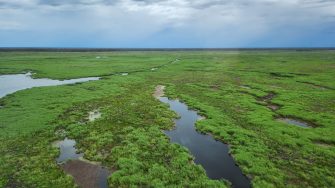
Date: Thursday November 10th 2022
Project: Eastern Australian Waterbird Survey
Observers: John Porter & Shannon Dundas
Pilot: Alex Katopodis
We depart Griffith and set our GPS to the great Cumbung Swamp, which is a large freshwater marsh at the junction of the Lachlan and lower Murrumbidgee rivers. Once again there is so much water that we use transects to sample the wetland. As anticipated waterbird densities are low but there is good diversity of species. Included in the list are herons, Black-tailed Native Hens, Purple Swamphens, spoonbill and egrets as well as Wood Duck, Grey Teal and Black Duck.
The great Cumbung Swamp.
The great Cumbung Swamp.
The great Cumbung Swamp.
From the Cumbung swamp it is a short hop to the Booligal wetlands on the lower Lachlan, they are formed by the main channel and its distributary channels Merrimajeel and Merowie creeks. More transects are required because of the extent of water, and we again find low densities but good diversity of waterbirds including egrets, ibis, herons Black-tailed Native Hens, Purple Swamphens, as well as Wood Duck, Grey Teal and Black Duck.
It’s a fitting end to the last day of our 40th annual survey when we find a huge Straw-necked Ibis colony with around 30-35,000 ibis busily nesting, another spectacular sight in a year of many big breeding events driven by unprecented flooding in south eastern parts of the continent. Central Australia has also received rainfall however the level of flooding is much lower.
After completing our counts we head back to Bankstown to gather and collate our data.

